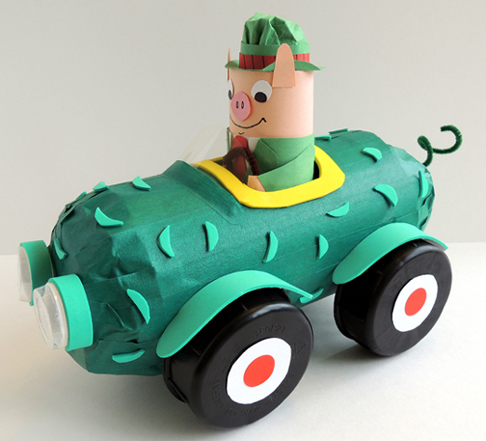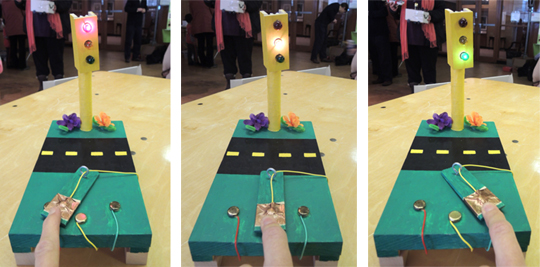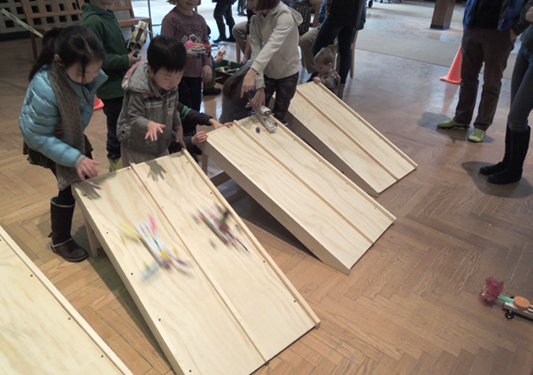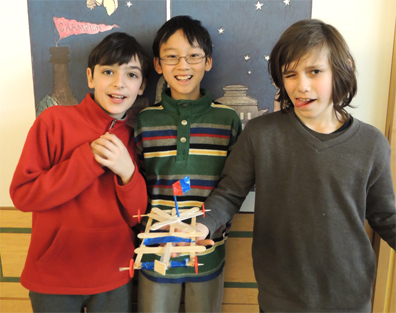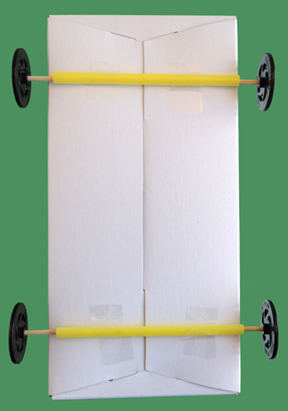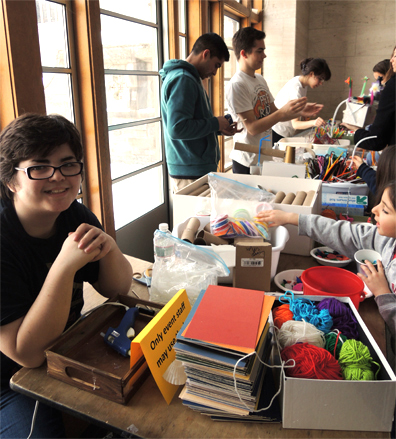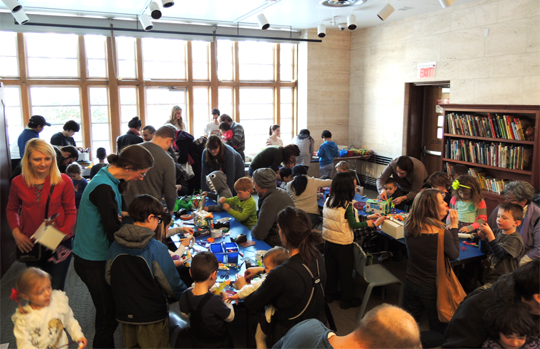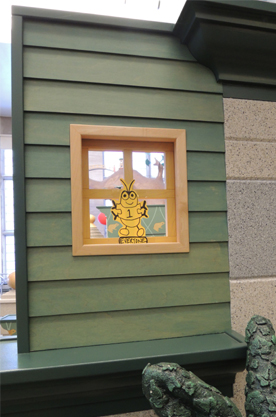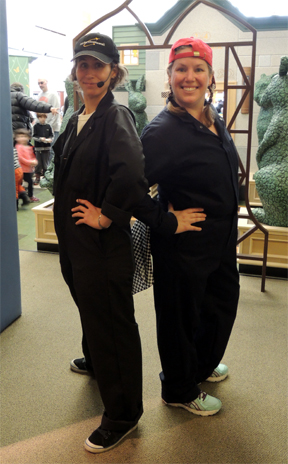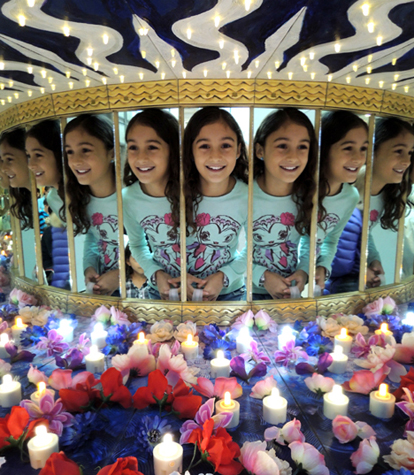 Who knew infinity could be so beautiful? I’ve returned with Part II of the Digitopolis event post (Part I can be found here) and thought I would start it off with one of the stars of the show! The above image was taken inside an Infinity Box, one of multiple creations by Los Angeles-based artist, Matt Elson. Matt’s boxes have been exhibited at colleges, science centers, festivals, and museums. He generously loaned us two (titled Radiance, and You & Me Together) for our math event.
Who knew infinity could be so beautiful? I’ve returned with Part II of the Digitopolis event post (Part I can be found here) and thought I would start it off with one of the stars of the show! The above image was taken inside an Infinity Box, one of multiple creations by Los Angeles-based artist, Matt Elson. Matt’s boxes have been exhibited at colleges, science centers, festivals, and museums. He generously loaned us two (titled Radiance, and You & Me Together) for our math event.
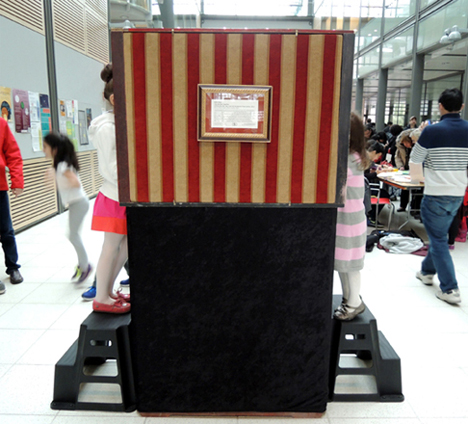 The boxes are designed to be infinite, interactive environments that play with your perception and inspire inquisitiveness and wonder. They were in constant use during the event, and there were lots of shrieks of amazement, enthusiastic explosions of “Cool!” and long, drawn out utterances of “Woooooow…”
The boxes are designed to be infinite, interactive environments that play with your perception and inspire inquisitiveness and wonder. They were in constant use during the event, and there were lots of shrieks of amazement, enthusiastic explosions of “Cool!” and long, drawn out utterances of “Woooooow…”
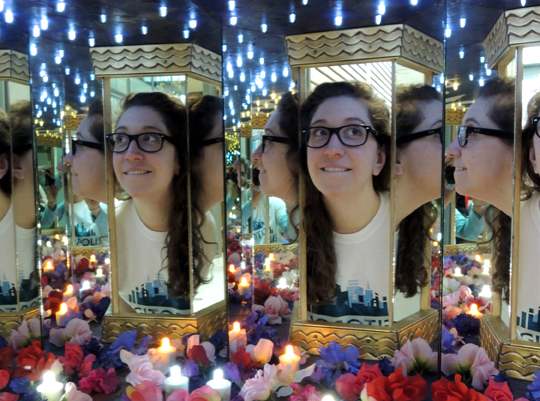 Digitopolis was not without its celebrities, including the King of Numbers himself. I speak, of course, of the Mathamagician.
Digitopolis was not without its celebrities, including the King of Numbers himself. I speak, of course, of the Mathamagician.
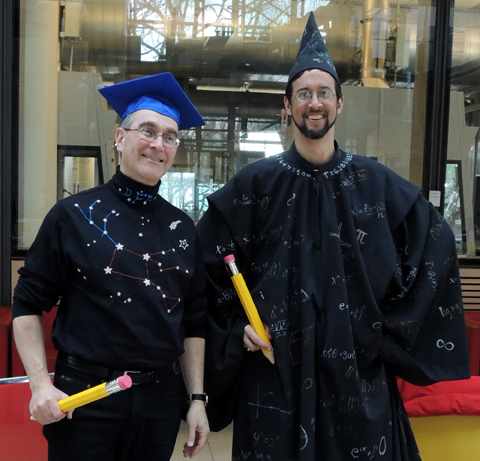 That’s real-life mathamagician Brent Ferguson on the right, grinning away under the pointy hat covered with equations. He’s math faculty at the Lawrenceville School, and in 2013, he was awarded the National Museum of Mathamatics’ Rosenthal Prize for innovation in math teaching. On the left is Dr. Dan Fishman, a high school math teacher, who, like Brent, has unbridled enthusiasm for all things math.
That’s real-life mathamagician Brent Ferguson on the right, grinning away under the pointy hat covered with equations. He’s math faculty at the Lawrenceville School, and in 2013, he was awarded the National Museum of Mathamatics’ Rosenthal Prize for innovation in math teaching. On the left is Dr. Dan Fishman, a high school math teacher, who, like Brent, has unbridled enthusiasm for all things math.
Together, Brent and Dan staffed the “Ask the Mathamagician” table. Kids could walk up and ask them any question they could possibly think of involving math. We had prompt cards on the table to get things started:
Why do you like math?
What’s an irrational number?
What’s the biggest number there is?
Why is math important?
Why does a negative times a negative equal a positive?
Is zero a number?
What’s a perfect number?
What’s that crazy math thing with the exclamation point?
What’s an imaginary number?
Know any good math jokes?
What’s your favorite equation?
Brent and Dan brought a whole bunch of math toys and puzzles with them. It was an irresistible treasure trove of numerical goodies.
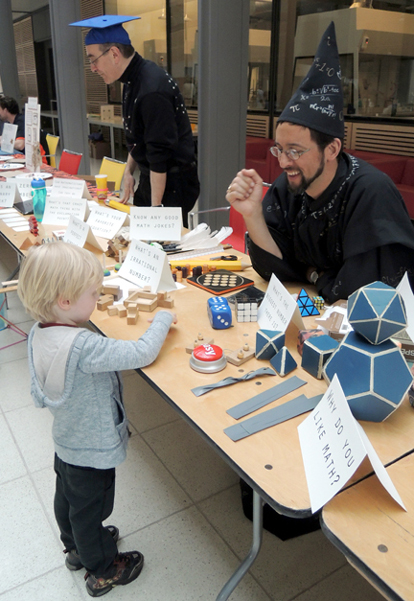 Also at the Mathamagican’s table were three Digitopolis “tourism” posters for families to take home (the posters were inspired by this fantastic NASA concept). The first two posters are by Princeton University senior, Aliisa Lee. The third poster is by freshman Demi Zhang.
Also at the Mathamagican’s table were three Digitopolis “tourism” posters for families to take home (the posters were inspired by this fantastic NASA concept). The first two posters are by Princeton University senior, Aliisa Lee. The third poster is by freshman Demi Zhang.
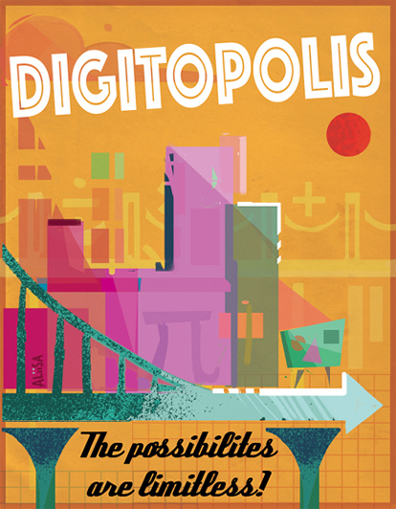
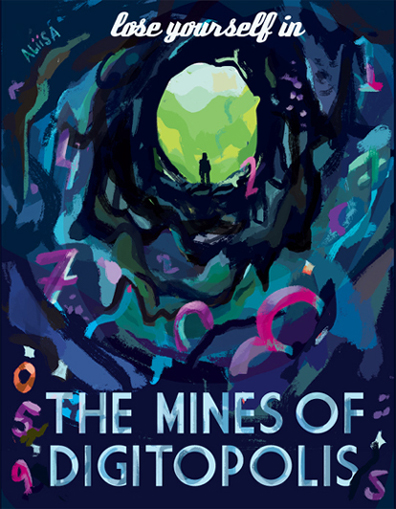
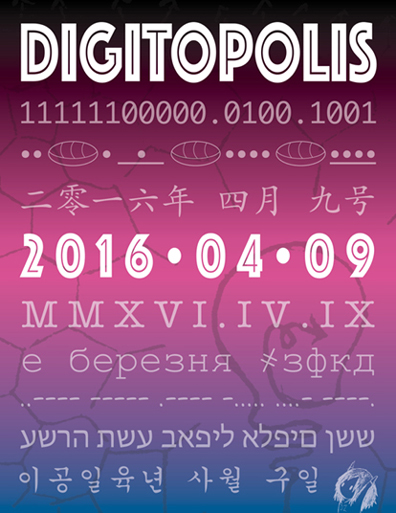 A quick word about the Mathamagician’s costume. The robes and hat were made by freshman James Jared, who ingeniously modified this Jedi robe. Then Casandra used silver and gold metallic fabric markers to draw real, honest-to-goodness math equations on them. We snapped a couple shots so you can get the full effect!
A quick word about the Mathamagician’s costume. The robes and hat were made by freshman James Jared, who ingeniously modified this Jedi robe. Then Casandra used silver and gold metallic fabric markers to draw real, honest-to-goodness math equations on them. We snapped a couple shots so you can get the full effect!
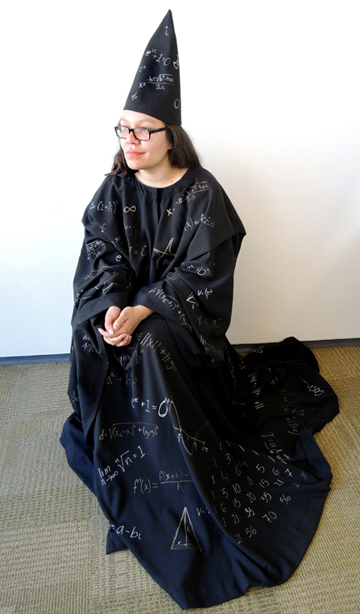
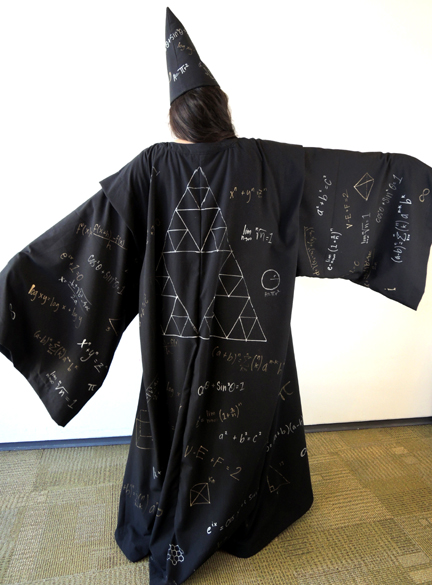 The Mathamagician wasn’t the only celebrity in Digitopolis that day. Does this gentleman look familiar to you?
The Mathamagician wasn’t the only celebrity in Digitopolis that day. Does this gentleman look familiar to you?
 Yup, it’s Albert Einstein. Or rather, professional reenactor Bill Agress playing Albert Einstein. Mr. Einstein circulated the event floor, chatted with kids, answered questions about his life and work, tried an activity or two, and posed for pictures. And yes – he wasn’t wearing any socks.
Yup, it’s Albert Einstein. Or rather, professional reenactor Bill Agress playing Albert Einstein. Mr. Einstein circulated the event floor, chatted with kids, answered questions about his life and work, tried an activity or two, and posed for pictures. And yes – he wasn’t wearing any socks.
In addition to being one of world’s most famous theoretical physicists (and no slouch at mathematics either), did you know that Einstein was a resident of Princeton? He emigrated here in 1933 to join the faculty of at the newly-created Institute for Advanced Study.
The Historical Society of Princeton put together a terrific mini-exhibit on Einstein in Princeton (my favorite is that photo of him wearing the fuzzy slippers). Families were invited to take home a map of notable Einstein haunts around town as well.
 They also whipped up an Einstein quiz for kids to try (the answers, by the way are B, A, B, C, B, C). The prize was a cool little puzzle. I found some terrific ones at Oriental Trading Company (the ones below are from the “Mind Teaser Game Assortment”).
They also whipped up an Einstein quiz for kids to try (the answers, by the way are B, A, B, C, B, C). The prize was a cool little puzzle. I found some terrific ones at Oriental Trading Company (the ones below are from the “Mind Teaser Game Assortment”).
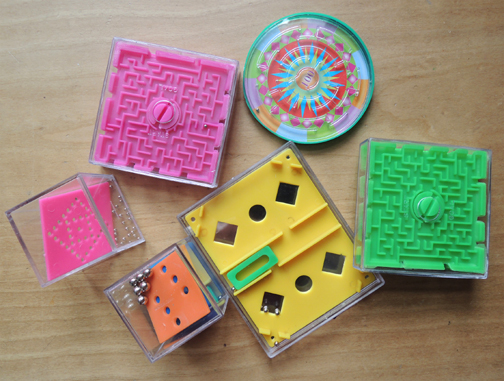 Elsewhere in Digitopolis, another math wizard was hard at work. This is Emile Oshima, a junior at Princeton and master of the Japanese abacus. Next to him is senior Rei Mastsuura.
Elsewhere in Digitopolis, another math wizard was hard at work. This is Emile Oshima, a junior at Princeton and master of the Japanese abacus. Next to him is senior Rei Mastsuura.
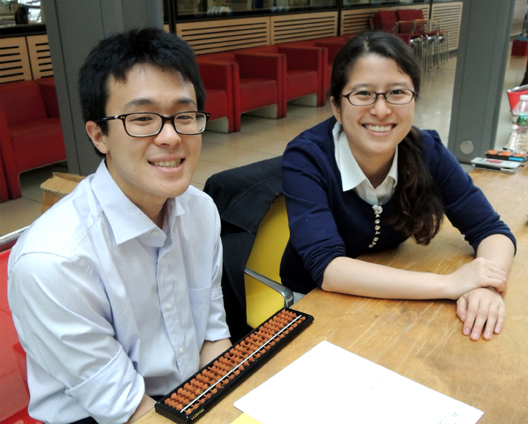 In addition to having Emile and Rei teaching kids how to use an abacus, Emile raced kids (and parents!) armed with electronic calculators to see who could reach the product of 3 x 3 multiplication problems faster. Emile always won. He was lightning fast!
In addition to having Emile and Rei teaching kids how to use an abacus, Emile raced kids (and parents!) armed with electronic calculators to see who could reach the product of 3 x 3 multiplication problems faster. Emile always won. He was lightning fast!
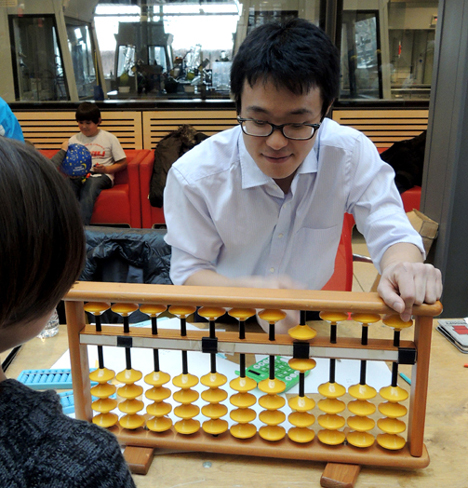 Meanwhile, at another event table, another calculator was keeping kids busy. But this calculator was rather…odd.
Meanwhile, at another event table, another calculator was keeping kids busy. But this calculator was rather…odd.
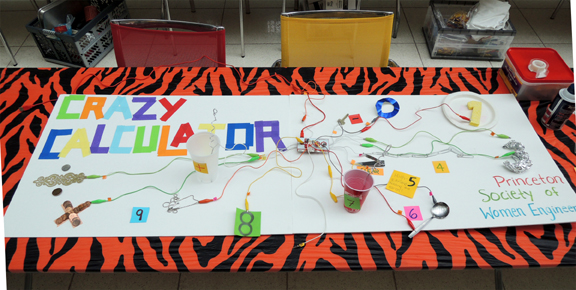 The “Crazy Calculator” was designed by the Princeton Society of Women Engineers using 2 Makey Makey sets. Have you seen Makey Makey? It’s pretty awesome. Each set consists of wired alligator clips, a small central board, and computer software.
The “Crazy Calculator” was designed by the Princeton Society of Women Engineers using 2 Makey Makey sets. Have you seen Makey Makey? It’s pretty awesome. Each set consists of wired alligator clips, a small central board, and computer software.
Attach the alligator clip to anything that conducts electricity, and you can do all sorts of crazy things. Turn bananas into a keyboard, or use Play-doe like a video game controller. The Women Engineers used all sorts of things to build their calculator – tin foil, wet sponges, water, metal objects, shaving cream, flowers, even high fives!
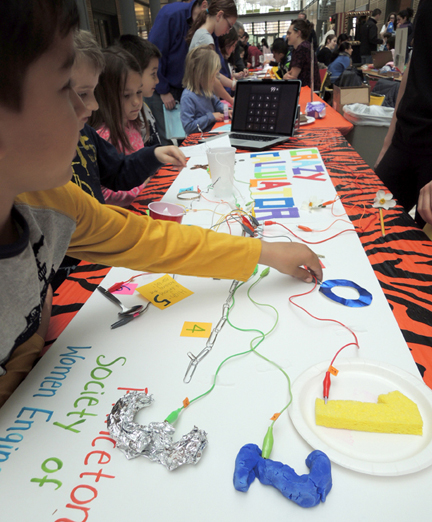 Interspersed with the other event tables were five “Pop Up History” activities that tied together math and history. These tables were designed to be simple, stand-alone, and un-staffed.
Interspersed with the other event tables were five “Pop Up History” activities that tied together math and history. These tables were designed to be simple, stand-alone, and un-staffed.
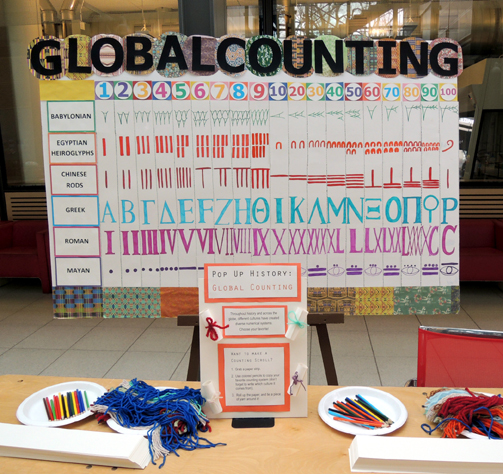 At “Global Counting,” kids could see diverse numerical systems on a big display board (the book Go Figure: A Totally Cool Book About Numbers (DK, 2005) was very helpful in this regard). Then, kids copied their favorite number system on a 3.5″ x 17″ strip of paper, and used yarn to turn it into a little scroll.
At “Global Counting,” kids could see diverse numerical systems on a big display board (the book Go Figure: A Totally Cool Book About Numbers (DK, 2005) was very helpful in this regard). Then, kids copied their favorite number system on a 3.5″ x 17″ strip of paper, and used yarn to turn it into a little scroll.
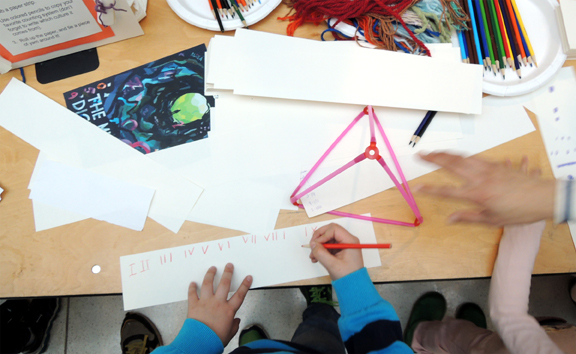 At another table were Möbius strips, a must-have for any hands-on math event. Discovered in 1858 by German mathematician August Ferdinand Möbius, the strip demonstrates how a piece of paper can have only one side! All it takes is a 2.5″ x 28″ piece of poster board, tape, and some instructions.
At another table were Möbius strips, a must-have for any hands-on math event. Discovered in 1858 by German mathematician August Ferdinand Möbius, the strip demonstrates how a piece of paper can have only one side! All it takes is a 2.5″ x 28″ piece of poster board, tape, and some instructions.
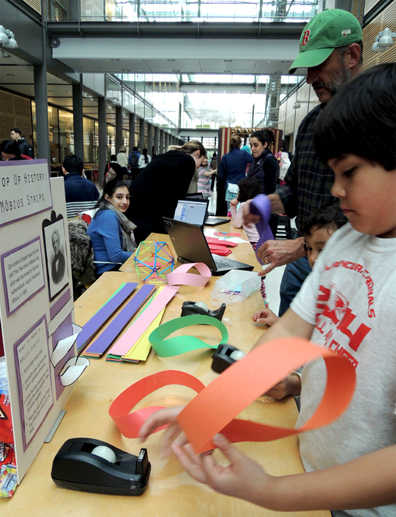 Another hands-on math must-have? Tangram puzzles. Originating in China, tangram puzzles were first introduced to Europe in the 19th century. There are plenty of inexpensive tabletop tangrams out there, but we decided to splurge on some giant foam floor size versions (thinner ones purchased from SimplyFun, chunkier ones from Fat Brain Toys). Later, these were donated to a local non-profit family shelter.
Another hands-on math must-have? Tangram puzzles. Originating in China, tangram puzzles were first introduced to Europe in the 19th century. There are plenty of inexpensive tabletop tangrams out there, but we decided to splurge on some giant foam floor size versions (thinner ones purchased from SimplyFun, chunkier ones from Fat Brain Toys). Later, these were donated to a local non-profit family shelter.
 The fourth Pop Up History table was called “Tally Hides.” Some American Indian tribes kept track of important things by making tally marks on animal hides and tree bark. Definitely a cool way to count!
The fourth Pop Up History table was called “Tally Hides.” Some American Indian tribes kept track of important things by making tally marks on animal hides and tree bark. Definitely a cool way to count!
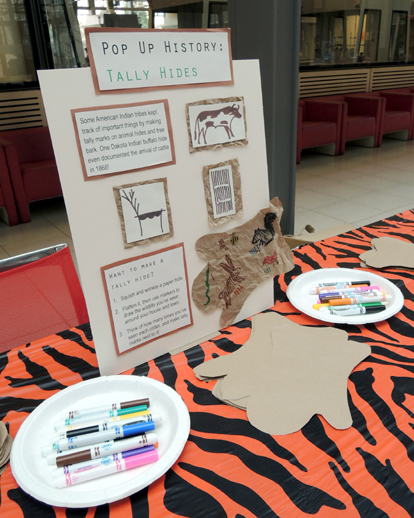 Before the event, we cut 9″ x 12″ pieces of brown paper into the shape of a hide. During the event, kids wrinkled the paper, flattened it out, and used markers to draw the wildlife they’ve seen around their homes and town. Then, they estimated how many times they’d seen each critter, and made a tally mark next to it. The project is originally from The Secret Life of Math (Williamson Books, 2005).
Before the event, we cut 9″ x 12″ pieces of brown paper into the shape of a hide. During the event, kids wrinkled the paper, flattened it out, and used markers to draw the wildlife they’ve seen around their homes and town. Then, they estimated how many times they’d seen each critter, and made a tally mark next to it. The project is originally from The Secret Life of Math (Williamson Books, 2005).
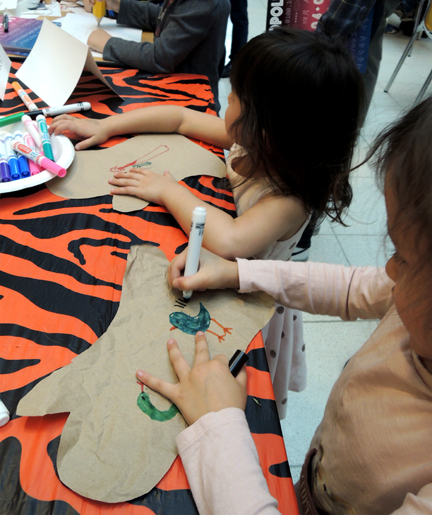 The final history table was called “Tile Tessellations.” Decorating surfaces with tiles spans many cultures, and many centuries. But did you know that the geometry in Early Islamic art was so intricate, it was unrivaled for over 500 years?
The final history table was called “Tile Tessellations.” Decorating surfaces with tiles spans many cultures, and many centuries. But did you know that the geometry in Early Islamic art was so intricate, it was unrivaled for over 500 years?
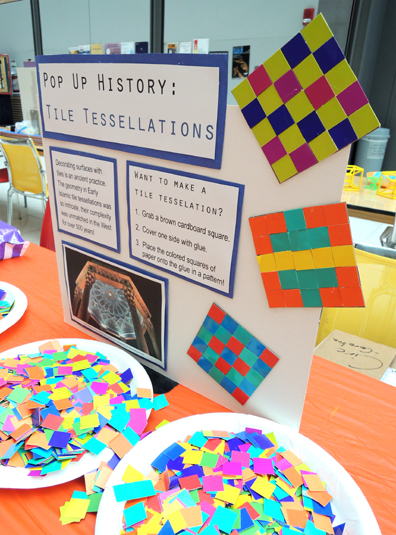 Kids put their tiling and tessellating skills to work by gluing 3/4″ paper tiles to a 6″ x 6″ square of tagboard. This project was really bright and beautiful.
Kids put their tiling and tessellating skills to work by gluing 3/4″ paper tiles to a 6″ x 6″ square of tagboard. This project was really bright and beautiful.
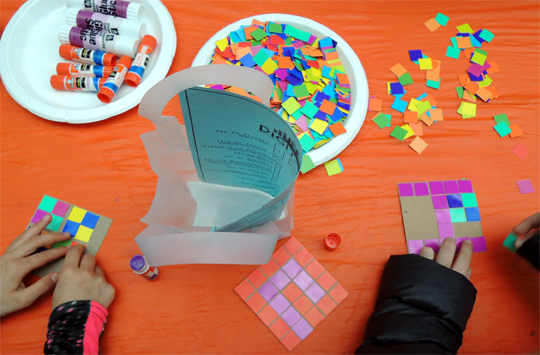 That’s it for history – how about some games? JaZams, our local family-owned toy store hosted a event area called “The Game is Afoot.” JaZams chose 8 math games for various age ranges, and set each of them up on a series of tables. Kids could drop by to play the waaaaay popular Rubik’s Race…
That’s it for history – how about some games? JaZams, our local family-owned toy store hosted a event area called “The Game is Afoot.” JaZams chose 8 math games for various age ranges, and set each of them up on a series of tables. Kids could drop by to play the waaaaay popular Rubik’s Race…
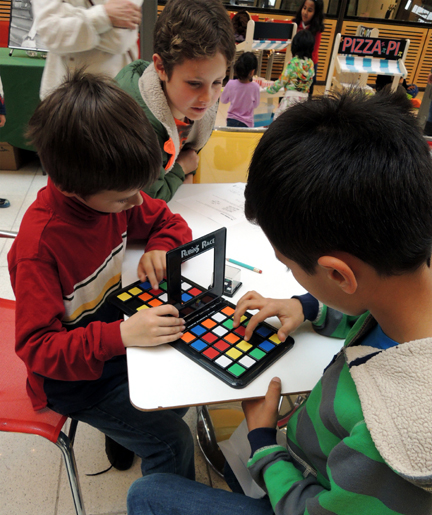 Or entire families could take a break and play Number Ninjas.
Or entire families could take a break and play Number Ninjas.
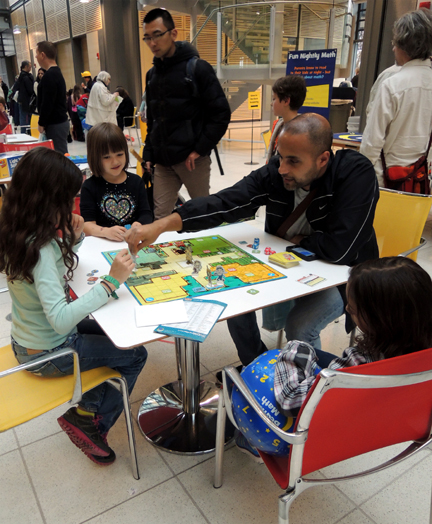 Heck, maybe you could even beat Einstein at Qbitz! After the event, the games were donated to a local non-profit family shelter.
Heck, maybe you could even beat Einstein at Qbitz! After the event, the games were donated to a local non-profit family shelter.
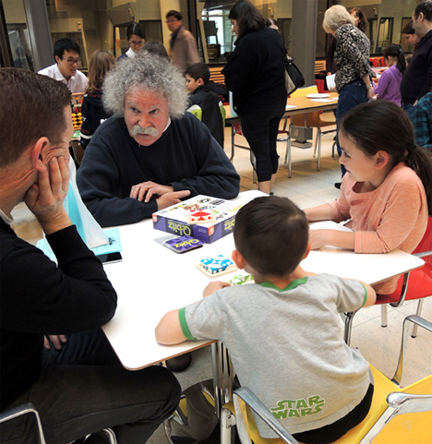 For the musically adventurous, there was “Musical Fractions,” an activity composed by senior Matt Smith and freshman Demi Zhang. Kids used percussion instruments (assorted floor drums, wood blocks, maracas, a wooden fish, claves, and sand blocks) to learn how to play, and recognize, wholes, halves, quarters, and eighths. They also learned about musical structure and patterns.
For the musically adventurous, there was “Musical Fractions,” an activity composed by senior Matt Smith and freshman Demi Zhang. Kids used percussion instruments (assorted floor drums, wood blocks, maracas, a wooden fish, claves, and sand blocks) to learn how to play, and recognize, wholes, halves, quarters, and eighths. They also learned about musical structure and patterns.
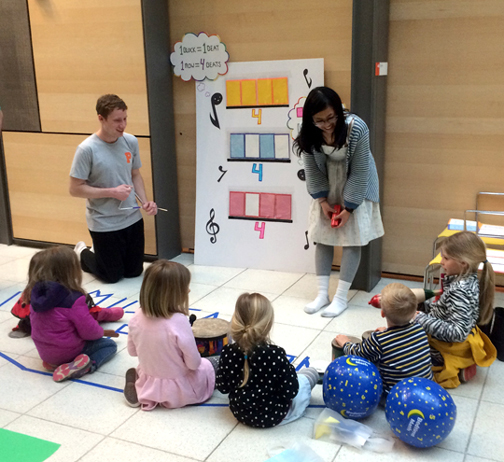 Each instructional session ranged between 10 to 15 minutes. I wasn’t able to catch an entire one, but I did manage to grab a few seconds of this one. Just listen to those fractions!
Each instructional session ranged between 10 to 15 minutes. I wasn’t able to catch an entire one, but I did manage to grab a few seconds of this one. Just listen to those fractions!
I have one last thing to share with you. Team Digitopolis in their awesome event t-shirts.
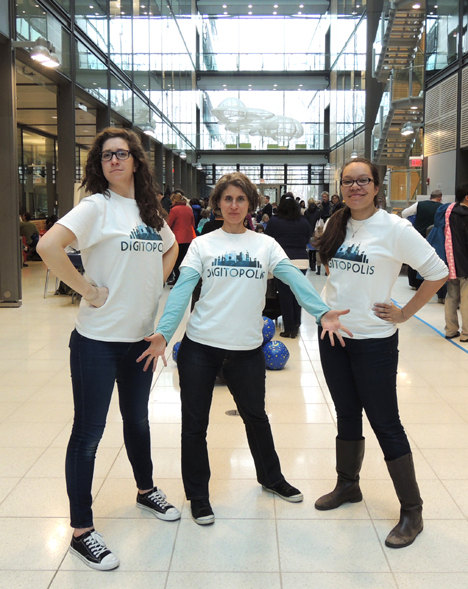 At big events like this, my staff and I wear costumes so that people can find us quickly in the crowds (helloooo Victorian Steampunk spelunker). For Digitopolis, however, I decided to go with t-shirts, and asked student artist Aliisa Lee to design them. Here’s a closer look at her beautiful cityscape!
At big events like this, my staff and I wear costumes so that people can find us quickly in the crowds (helloooo Victorian Steampunk spelunker). For Digitopolis, however, I decided to go with t-shirts, and asked student artist Aliisa Lee to design them. Here’s a closer look at her beautiful cityscape!
 On the backs were our favorite numbers. Let’s hear it for 9, 2, and 11! Woot woot!
On the backs were our favorite numbers. Let’s hear it for 9, 2, and 11! Woot woot!
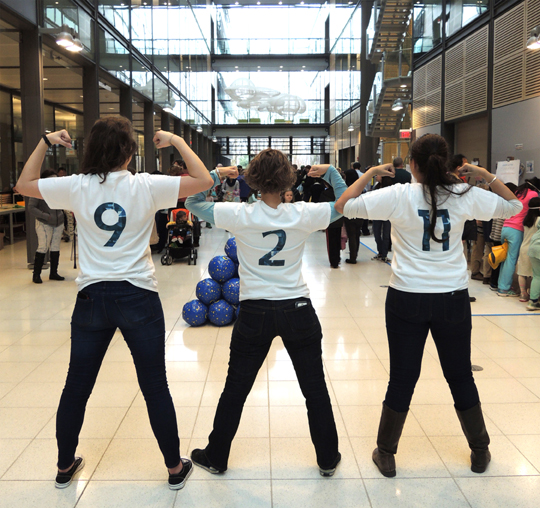 I’d like to send a million, trillion, zillion, googolplex thanks to everyone who made this event possible, and who generously gave their time to make math fun, approachable, unusual and fun. An extra shout out to the Princeton University students, and the student athletes who volunteered so energetically and enthusiastically! Thank you so much, everyone!
I’d like to send a million, trillion, zillion, googolplex thanks to everyone who made this event possible, and who generously gave their time to make math fun, approachable, unusual and fun. An extra shout out to the Princeton University students, and the student athletes who volunteered so energetically and enthusiastically! Thank you so much, everyone!


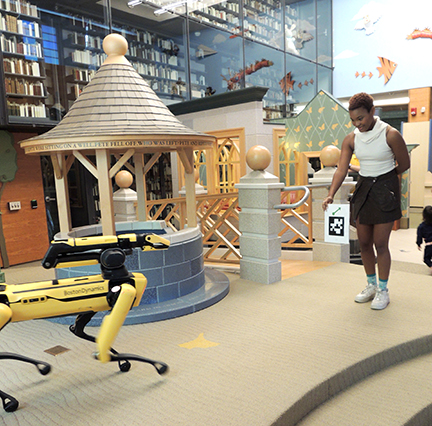


 Who knew infinity could be so beautiful? I’ve returned with Part II of the Digitopolis event post (
Who knew infinity could be so beautiful? I’ve returned with Part II of the Digitopolis event post ( The boxes are designed to be infinite, interactive environments that play with your perception and inspire inquisitiveness and wonder. They were in constant use during the event, and there were lots of shrieks of amazement, enthusiastic explosions of “Cool!” and long, drawn out utterances of “Woooooow…”
The boxes are designed to be infinite, interactive environments that play with your perception and inspire inquisitiveness and wonder. They were in constant use during the event, and there were lots of shrieks of amazement, enthusiastic explosions of “Cool!” and long, drawn out utterances of “Woooooow…” Digitopolis was not without its celebrities, including the King of Numbers himself. I speak, of course, of the Mathamagician.
Digitopolis was not without its celebrities, including the King of Numbers himself. I speak, of course, of the Mathamagician. That’s real-life mathamagician Brent Ferguson on the right, grinning away under the pointy hat covered with equations. He’s math faculty at the Lawrenceville School, and in 2013, he was awarded the National Museum of Mathamatics’ Rosenthal Prize for innovation in math teaching. On the left is Dr. Dan Fishman, a high school math teacher, who, like Brent, has unbridled enthusiasm for all things math.
That’s real-life mathamagician Brent Ferguson on the right, grinning away under the pointy hat covered with equations. He’s math faculty at the Lawrenceville School, and in 2013, he was awarded the National Museum of Mathamatics’ Rosenthal Prize for innovation in math teaching. On the left is Dr. Dan Fishman, a high school math teacher, who, like Brent, has unbridled enthusiasm for all things math. Also at the Mathamagican’s table were three Digitopolis “tourism” posters for families to take home (the posters were inspired by
Also at the Mathamagican’s table were three Digitopolis “tourism” posters for families to take home (the posters were inspired by 

 A quick word about the Mathamagician’s costume. The robes and hat were made by freshman James Jared, who ingeniously modified
A quick word about the Mathamagician’s costume. The robes and hat were made by freshman James Jared, who ingeniously modified 
 The Mathamagician wasn’t the only celebrity in Digitopolis that day. Does this gentleman look familiar to you?
The Mathamagician wasn’t the only celebrity in Digitopolis that day. Does this gentleman look familiar to you? Yup, it’s Albert Einstein. Or rather, professional reenactor Bill Agress playing Albert Einstein. Mr. Einstein circulated the event floor, chatted with kids, answered questions about his life and work, tried an activity or two, and posed for pictures. And yes – he wasn’t wearing any socks.
Yup, it’s Albert Einstein. Or rather, professional reenactor Bill Agress playing Albert Einstein. Mr. Einstein circulated the event floor, chatted with kids, answered questions about his life and work, tried an activity or two, and posed for pictures. And yes – he wasn’t wearing any socks. They also whipped up an
They also whipped up an  Elsewhere in Digitopolis, another math wizard was hard at work. This is Emile Oshima, a junior at Princeton and master of the Japanese abacus. Next to him is senior Rei Mastsuura.
Elsewhere in Digitopolis, another math wizard was hard at work. This is Emile Oshima, a junior at Princeton and master of the Japanese abacus. Next to him is senior Rei Mastsuura. In addition to having Emile and Rei teaching kids how to use an abacus, Emile raced kids (and parents!) armed with electronic calculators to see who could reach the product of 3 x 3 multiplication problems faster. Emile always won. He was lightning fast!
In addition to having Emile and Rei teaching kids how to use an abacus, Emile raced kids (and parents!) armed with electronic calculators to see who could reach the product of 3 x 3 multiplication problems faster. Emile always won. He was lightning fast! Meanwhile, at another event table, another calculator was keeping kids busy. But this calculator was rather…odd.
Meanwhile, at another event table, another calculator was keeping kids busy. But this calculator was rather…odd. The “Crazy Calculator” was designed by the Princeton Society of Women Engineers using 2 Makey Makey sets. Have you seen Makey Makey? It’s pretty awesome. Each set consists of wired alligator clips, a small central board, and computer software.
The “Crazy Calculator” was designed by the Princeton Society of Women Engineers using 2 Makey Makey sets. Have you seen Makey Makey? It’s pretty awesome. Each set consists of wired alligator clips, a small central board, and computer software. Interspersed with the other event tables were five “Pop Up History” activities that tied together math and history. These tables were designed to be simple, stand-alone, and un-staffed.
Interspersed with the other event tables were five “Pop Up History” activities that tied together math and history. These tables were designed to be simple, stand-alone, and un-staffed. At “Global Counting,” kids could see diverse numerical systems on a big display board (the book Go Figure: A Totally Cool Book About Numbers (DK, 2005) was very helpful in this regard). Then, kids copied their favorite number system on a 3.5″ x 17″ strip of paper, and used yarn to turn it into a little scroll.
At “Global Counting,” kids could see diverse numerical systems on a big display board (the book Go Figure: A Totally Cool Book About Numbers (DK, 2005) was very helpful in this regard). Then, kids copied their favorite number system on a 3.5″ x 17″ strip of paper, and used yarn to turn it into a little scroll. At another table were Möbius strips, a must-have for any hands-on math event. Discovered in 1858 by German mathematician August Ferdinand Möbius, the strip demonstrates how a piece of paper can have only one side! All it takes is a 2.5″ x 28″ piece of poster board, tape, and some
At another table were Möbius strips, a must-have for any hands-on math event. Discovered in 1858 by German mathematician August Ferdinand Möbius, the strip demonstrates how a piece of paper can have only one side! All it takes is a 2.5″ x 28″ piece of poster board, tape, and some  Another hands-on math must-have? Tangram puzzles. Originating in China, tangram puzzles were first introduced to Europe in the 19th century. There are plenty of inexpensive tabletop tangrams out there, but we decided to splurge on some giant foam floor size versions (thinner ones purchased from SimplyFun, chunkier ones from Fat Brain Toys). Later, these were donated to a local non-profit family shelter.
Another hands-on math must-have? Tangram puzzles. Originating in China, tangram puzzles were first introduced to Europe in the 19th century. There are plenty of inexpensive tabletop tangrams out there, but we decided to splurge on some giant foam floor size versions (thinner ones purchased from SimplyFun, chunkier ones from Fat Brain Toys). Later, these were donated to a local non-profit family shelter. The fourth Pop Up History table was called “Tally Hides.” Some American Indian tribes kept track of important things by making tally marks on animal hides and tree bark. Definitely a cool way to count!
The fourth Pop Up History table was called “Tally Hides.” Some American Indian tribes kept track of important things by making tally marks on animal hides and tree bark. Definitely a cool way to count! Before the event, we cut 9″ x 12″ pieces of brown paper into the shape of a hide. During the event, kids wrinkled the paper, flattened it out, and used markers to draw the wildlife they’ve seen around their homes and town. Then, they estimated how many times they’d seen each critter, and made a tally mark next to it. The project is originally from The Secret Life of Math (Williamson Books, 2005).
Before the event, we cut 9″ x 12″ pieces of brown paper into the shape of a hide. During the event, kids wrinkled the paper, flattened it out, and used markers to draw the wildlife they’ve seen around their homes and town. Then, they estimated how many times they’d seen each critter, and made a tally mark next to it. The project is originally from The Secret Life of Math (Williamson Books, 2005). The final history table was called “Tile Tessellations.” Decorating surfaces with tiles spans many cultures, and many centuries. But did you know that the geometry in Early Islamic art was so intricate, it was unrivaled for over 500 years?
The final history table was called “Tile Tessellations.” Decorating surfaces with tiles spans many cultures, and many centuries. But did you know that the geometry in Early Islamic art was so intricate, it was unrivaled for over 500 years? Kids put their tiling and tessellating skills to work by gluing 3/4″ paper tiles to a 6″ x 6″ square of
Kids put their tiling and tessellating skills to work by gluing 3/4″ paper tiles to a 6″ x 6″ square of  That’s it for history – how about some games?
That’s it for history – how about some games?  Or entire families could take a break and play Number Ninjas.
Or entire families could take a break and play Number Ninjas. Heck, maybe you could even beat Einstein at Qbitz! After the event, the games were donated to a local non-profit family shelter.
Heck, maybe you could even beat Einstein at Qbitz! After the event, the games were donated to a local non-profit family shelter. For the musically adventurous, there was “Musical Fractions,” an activity composed by senior Matt Smith and freshman Demi Zhang. Kids used percussion instruments (assorted floor drums, wood blocks, maracas, a wooden fish, claves, and sand blocks) to learn how to play, and recognize, wholes, halves, quarters, and eighths. They also learned about musical structure and patterns.
For the musically adventurous, there was “Musical Fractions,” an activity composed by senior Matt Smith and freshman Demi Zhang. Kids used percussion instruments (assorted floor drums, wood blocks, maracas, a wooden fish, claves, and sand blocks) to learn how to play, and recognize, wholes, halves, quarters, and eighths. They also learned about musical structure and patterns. Each instructional session ranged between 10 to 15 minutes. I wasn’t able to catch an entire one, but I did manage to grab a few seconds of this one. Just listen to those fractions!
Each instructional session ranged between 10 to 15 minutes. I wasn’t able to catch an entire one, but I did manage to grab a few seconds of this one. Just listen to those fractions! At big events like this, my staff and I wear costumes so that people can find us quickly in the crowds (helloooo
At big events like this, my staff and I wear costumes so that people can find us quickly in the crowds (helloooo  On the backs were our favorite numbers. Let’s hear it for 9, 2, and 11! Woot woot!
On the backs were our favorite numbers. Let’s hear it for 9, 2, and 11! Woot woot! I’d like to send a million, trillion, zillion, googolplex thanks to everyone who made this event possible, and who generously gave their time to make math fun, approachable, unusual and fun. An extra shout out to the Princeton University students, and the student athletes who volunteered so energetically and enthusiastically! Thank you so much, everyone!
I’d like to send a million, trillion, zillion, googolplex thanks to everyone who made this event possible, and who generously gave their time to make math fun, approachable, unusual and fun. An extra shout out to the Princeton University students, and the student athletes who volunteered so energetically and enthusiastically! Thank you so much, everyone!